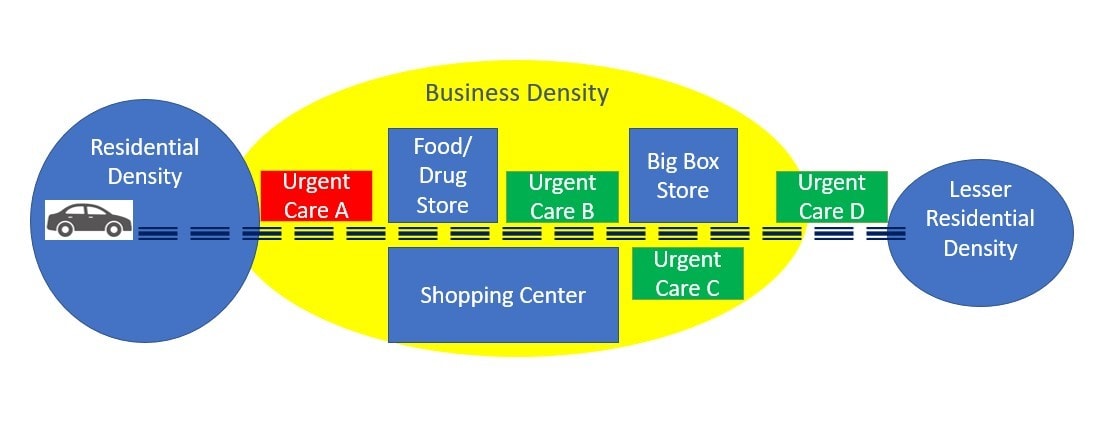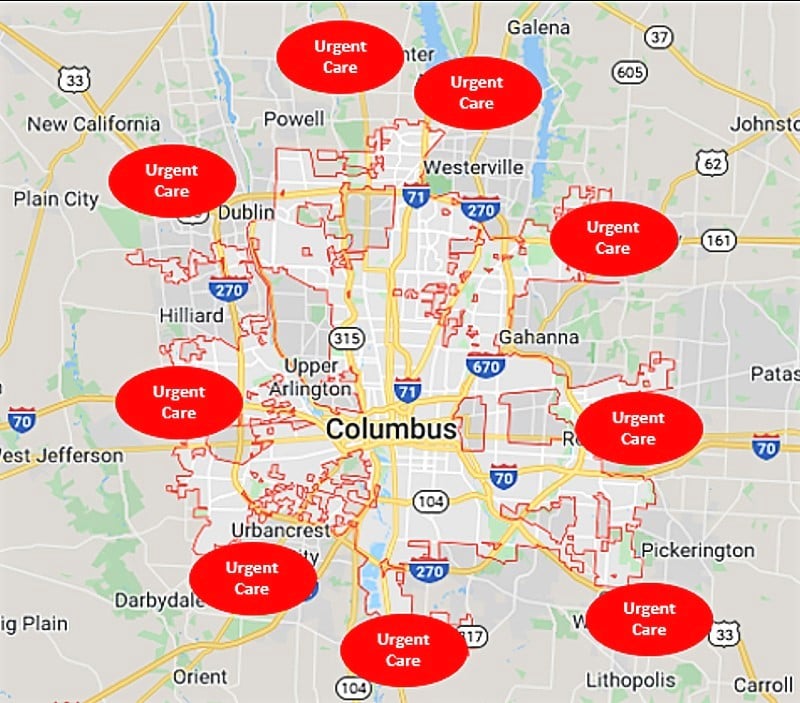Alan A. Ayers, MBA, is Chief Executive Officer of Velocity Urgent Care and is Practice Management Editor of The Journal of Urgent Care Medicine.
Urgent message: When competing in crowded, heavily saturated urgent care markets, employing strategic real estate tactics in site selection can give your urgent care center an edge over the competition.
Urgent care is a retail business, so site selection is critical in getting patients through the door. Most owner-operators understand the basic tenets of optimal site selection: close proximity to “big box” retail draws and grocers (areas that the coveted “soccer mom” demographic frequent), high-visibility from main thoroughfares and local traffic, well-lit and prominent signage, etc. In crowded and heavily saturated markets, however, your competitors may already have the town’s prime real estate locked up, leaving you wondering where to set up so that you can compete.
This is where strategic real estate tactics come into play and can give your urgent care center a competitive advantage. By evaluating the trade area population density, physical characteristics, geographic boundaries, and traffic and commuting patterns, you can strategically use site selection to build urgent care centers that will “intercept,” “box-in” and/or “flank” competing urgent cares, reducing the number of patients they will see. To that end, we’ll examine the aforementioned site selection tactics, and the ways each allows you to outposition the competition.
Trade Areas
A trade area is defined as a geographical region or location where most of a business’s sales volume occurs. Trade areas in densely populated urban locations will typically be smaller than those in wide open, rural, and less populated locations. A trade area in New York City, for example, will necessarily be smaller than one in, say, rural Arkansas given the differences in population density and the concentration of retail draws per square mile. A typical urgent care trade area will offer a wide variety of retail draws, such as:
- Grocery stores
- Fast food and sit-down restaurants
- Coffee shops
- Fitness centers and gyms
- Banks
- Drugstores
- Big-box retailers (eg, Walmart, Target, Kohls, Lowes)
- Shopping malls
- Retail strip malls
As a rule of thumb, the denser the population in an area, the shorter the drive time and/or distance that defines the trade area.
Intercepting
Intercepting means building an urgent care between the residential areas where people in the trade area live and the competing urgent care centers. For example, imagine a 5-mile radius trade area with a cluster of residential areas to the East and West of a centrally located retail draw zone. The residential area to the West is more densely populated than the residential area to the East. In this instance, your competitors are Urgent Care B, Urgent Care C, and Urgent Care D and your business is Urgent Care A. Urgent Care B, Urgent Care C, and Urgent Care D are located close to the retail zones, with Urgent Care D being closest to less densely populated Eastern residential area.
A major road artery (such as a state highway) brings the Western residents in and out of the centrally located trade area. By therefore building an urgent care right on the Western edge of the retail development, your business—Urgent Care A—intercepts patients who may have been en route to Urgent Care B, Urgent Care C, or Urgent Care D. Consumer behavior research shows that people will stop at the first urgent care they pass, so by choosing a location between people’s homes and the competition, your center can “grab” those people before they get to your competitors.
Example 1: Intercepting
Consumers tend to travel from less dense areas to more dense areas. In this illustration, residents to the West will travel to the central business density for services. Urgent Care A is therefore positioned to intercept those consumers en route to Urgent Care B, Urgent Care C, and Urgent Care D.

Boxing In
Boxing in is a similar strategy, and essentially another form of intercepting. Say that Urgent Care A and Urgent Care D (the easternmost and westernmost located urgent care centers, respectively, relative to the retail zone) have the same owner-operator or are part of the same chain in this scenario. By surrounding Urgent Care B and Urgent Care C in both directions, Urgent Care A and Urgent Care D would be “boxing in” the competition. Meaning, Urgent Care B and Urgent Care C assume they’re serving a wide trade area—the entire community—but in reality, they’re only serving the commercial/retail strip (where no one lives) because all the residential traffic to the East and West is being intercepted by Urgent Care A and Urgent Care D. Few patients would drive past Urgent Care A and Urgent Care D from the East and the West to utilize Urgent Care B and Urgent Care C in this instance.
Example 2: Boxing In
In this illustration, Urgent Care A and Urgent Care D are owned by the same entity. While Urgent Care B and Urgent Care C may think they’re serving the residential that draws to the nearby retailers, in effect that traffic is intercepted from both directions. This is called “boxing in” because the true size of B’s and C’s trade area is limited to the area of business density, where nobody lives.

Flanking
Flanking is related to boxing in, but this site selection tactic involves building urgent care locations around the periphery of a city. In general, people will always drive from lesser density to greater density, meaning they go from rural to urban given the greater number of retail draws located in the higher density areas. Therefore, a flanking strategy simply entails creating a “ring” of sorts around a city where strategically located urgent care centers intercept patients driving in from rural to urban. Flanking is best accomplishing by building urgent care centers in the “exurbs,” or the towns just beyond the suburbs of a major city. Example 3 shows what a flanking strategy might look like.
Example 3: Flanking
Consumers tend to travel from lesser residential and business density, to greater residential and business density. That’s because greater density is required to offer the types of services consumers want. A flanking strategy intercepts consumers who travel from more rural areas to more urban areas for services by locating on the major arteries in the outer suburbs (exurbs) that surround a city.

Conclusion
The value in each of these intercept-based site selection tactics is in how it limits the number of patients your competitors will see. If a competitor gets “boxed in” tight enough, it may be cut off from the majority of patients they intend to serve. In an extreme example, the retail zone may draw 200,000 people to its various retail draws, so the competing urgent care provider may believe there are 200,000 potential patients. If that urgent care is being boxed in and/or flanked by competitors, its actual trade area may only be the shopping center itself since the residential traffic driving in to retail zone is being intercepted. And since no significant population lives in a retail zone, that urgent care will struggle to maintain patient volumes, and eventually fail.
In crowded and oversaturated markets, your urgent care competition may already have their centers built out atop prime real estate located near coveted retail zones. An understanding of the key characteristics of the trade area, however, will allow you to employ strategic site selection tactics to outposition the competition and capture the patients they assumed would utilize their centers. By understanding the ways you can use geography and major traffic arteries to intercept, box-in, and flank competing urgent care centers, you limit the number of patients they will see while drawing those same patients to your own center.

